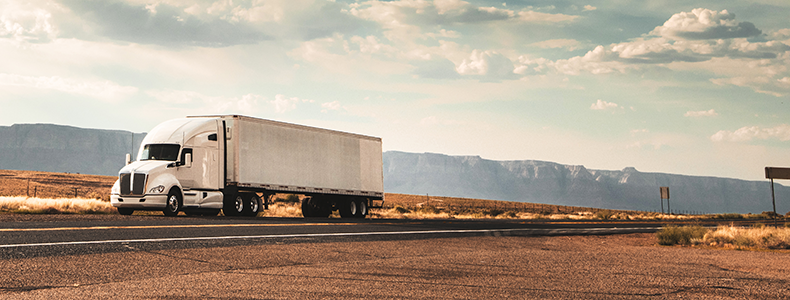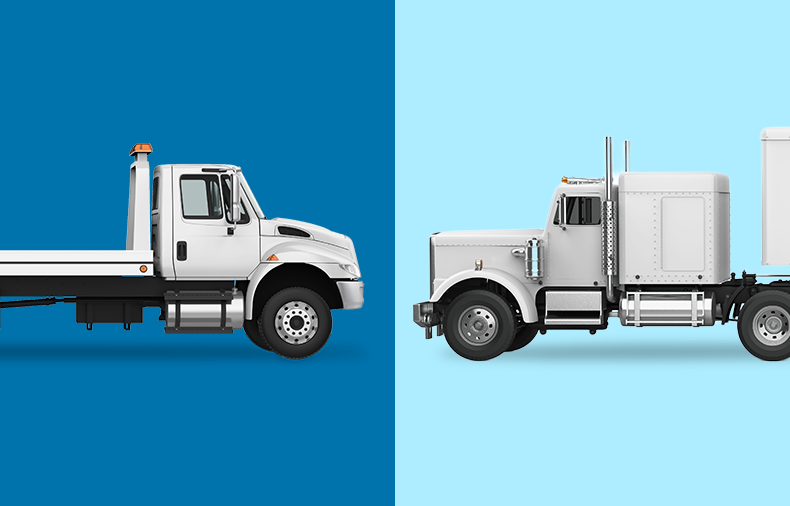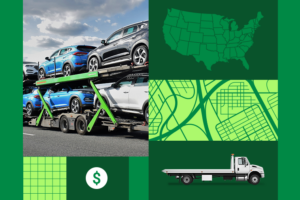When relocating your vehicle, one of your first decisions is whether to use open or enclosed car shipping. This choice impacts costs, security, delivery, and, ultimately, the experience you’ll have. Before picking a transport method, it’s essential to understand those key distinctions.
An open carrier utilizes a truck bed to expose cars to the elements en route. Enclosed covers vehicles inside trailers. At first glance, enclosed auto transport seems safer, yet more expensive because it eliminates weather factors but has vehicle size restrictions.
As you weigh cost savings against protection, consider what matters most — your budget or barrier from road debris — loading access or full coverage. By comparing the pros and cons of open and enclosed shipping, you can determine the best transportation solution for your situation. Keep reading to get the full breakdown of these popular auto transport options.
What is Open Car Shipping?

Open car shipping is exactly what it sounds like – transporting vehicles out in the open rather than inside an enclosed trailer. With available auto transport, cars ride on top of flatbed trailers or the upper level of auto carrier trucks, fully exposed to the elements during transit.
While it may sound risky, open car transport has distinct advantages:
Lower Costs: Without the added overhead of specialized trailers, available shipping costs are significantly less than enclosed options, with estimates averaging $600-$800 for regional transport and $700-$1,100 coast-to-coast.
Door-to-Door Convenience: Since open car haulers have easier street access, they can conveniently pick up and deliver vehicles directly from driveways or parking lots, saving clients extra stops and fees. Enclosed trailers often have restrictions requiring the use of terminals.
Flexibility & Availability: Open carriers have fewer vehicle size limitations and can transport anything from small sedans to large RVs. Most enclosed trailers max out at heights of 6 feet 8 inches tall. Additionally, abundant open transporters mean faster dispatch and response times when booking moves.
Modern Safety Standards: While open shipping presents slightly higher risks of road debris and exposure issues, providers implement many protections today, like specialty wheel nets, straps, and real-time GPS tracking that make the mode reliably safe overall. Technological advances transformed open shipping.
How Does Open Carrier Transport Work?
Open carrier transport moves vehicles out in the open air. Cars, trucks, and SUVs are driven up ramps onto large uncovered flatbed trucks. It’s like a parking lot on wheels!
Once vehicles are loaded on the truck beds, they are tied down tight. Special nets and straps hold cars stable and still for the whole ride. This keeps them from sliding around or getting scratched up.
During the trip, cars ride uncovered and exposed to the elements – sun, rain, debris, etc. So, vehicles on open carriers may get dirtier than enclosed shipping.
But open transport trucks can pick up and drop off at homes since they quickly drive down streets. Enclosed trailers are more significant and need more space. This door-to-door service saves time and money.
So, for anyone shipping vehicles across town or the country, open carriers offer a more flexible and cheaper way to move.
Common Use Cases
Open shipping works well for transporting most smaller passenger vehicles — cars, vans, SUVs, and trucks. It also handles oversized items like RVs, buses, and construction equipment within weight limits and permits.
People commonly use open transport for:
- Regional or long-distance relocation
- College student vehicle moves
- Military reassignments
- Seasonal snowbird moves
- Dealer inventory transfers
- Auction vehicles purchases
What is Enclosed Car Shipping?

With substantial cost savings over enclosed service, open carriers offer a budget way to ship mainstream vehicles requiring essential protection. The convenience and flexibility make it popular for many auto transport needs.
Enclosed car shipping refers to transporting vehicles inside specialized trailers shielded from exposure on all sides. Unlike open carriers, this shipping method protects cars from weather, road debris, and other environmental factors during transit.
How Enclosed Shipping Works Vehicles drive into truck trailers and ride inside a fully covered metal or high-density polymer container custom-built for auto transport. Doors are securely closed behind them with quality padding and straps inside to protect finishes. Enclosed trailers offer a complete barrier between vehicles and outside elements.
Enclosed containers also allow climate control options and GPS tracking for added security. However, the extra shelter and amenities do impact accessibility. Enclosed carriers need wider turning radiuses and are too tall to access some tunnels, parking garages, or lower overpasses. This often necessitates meeting at terminal depots for loading/unloading.
Who Benefits from Enclosed Shipping?
Since enclosed trailers fully protect vehicle exteriors and interiors, they provide ideal transport for:
- Luxury & Vintage Vehicles: For prized cars like Jaguars, Porsches, or vintage collector models, enclosed shipping eliminates the risks of damage from debris, precipitation, or bugs. It also prevents interior issues like dirt or stains.
- Show & Track Cars: Racing vehicles with aftermarket modifications and bottoms designed for controlled tracks would get chewed up, making long drives on highways. Enclosed offers protection for undercarriages, too.
- Motorcycles: Unlike larger vehicles, bikes don’t have roofs or fully sealed cabins to buffer weather and elements encountered on highways. Enclosed shipping keeps motorcycles wholly covered.
What Impacts the Costs of Car Shipping?
Why does open transport run cheaper than enclosed when moving vehicles? The main factor is overhead! Available carriers utilize basic uncovered truck beds, while enclosed use customized trailers. Trailers cost more to build, maintain, and haul. But both shipping modes have other considerations that raise or lower pricing.
Open Shipping Cost Drivers For open transport, the main variables include:
- Transport Distance: It costs more to ship vehicles cross-country than locally because of fuel and time. A 500-mile move may run $700+ but $250 within the same state.
- Vehicle Type: Larger or high-performance cars require specialized equipment. Moving a BMW convertible may run $800, while an F-150 costs $900+.
- Seasonal Demands: Peak snowbird seasons and summer moves increase pricing due to higher requests straining capacity.
Enclosed Shipping Cost Influences
For enclosed shipping, critical factors like those above remain, but additional considerations related to trailers themselves like:
- Trailer Size: Larger vehicle allowances mean bigger trailers and trucks to haul them, raising costs.
- Climate Controls: Opting for temperature or humidity regulation inside trailers adds charges to bills.
- Insurance: Enclosed companies take additional liability for higher value-at-risk vehicles. These insurance fees get built into pricing.
Open vs. Enclosed Car Shipping: How Costs Compare
When moving a vehicle any meaningful distance, most people want the best protection at the lowest price. Understanding cost differences between primary transport methods — open and enclosed — helps find that sweet spot.
Overall, open shipping runs cheaper as vehicles ride exposed on truck beds, saving carriers’ investment in specialized trailers. But there are times when enclosed makes financial sense despite higher base fees.
Cost Scenarios Favoring Open Transport
Regional Relocations For moves under 1,000 miles, open transport saves hundreds over enclosed. The enclosed equipment, real estate, and insurance overhead were required to be distributed over shorter trips, inflating each. A 500-mile open transport may run $600-$800 vs $1200+ for enclosed.
- Everyday Vehicles: For mainstream cars and trucks, open shipping risks like road debris and grime may matter less than the 30-50% savings. Optimal for transporting family sedans, trucks, and SUVs.
- Multiple Vehicle Transport: When moving household fleets or dealer inventory, multiplying enclosed fees for each car has a more significant impact. Open transport can carry 5-10 ordinary vehicles for 1-2 enclosed.
When Enclosed Shipping Justifies Costs
- Long Distance Trips: Cross-country trips above 1,500 miles close the price gap between open and enclosed, with costs sometimes running equally. Enclosed quality-of-delivery and security also gain appeal over such vast distances.
- Specialty Vehicles: For vintage classics, priceless exotics, custom sports vehicles, or luxury brands like BMW, Audi, or Porsche, enclosed’s generous protection often warrants a premium price, especially for older models.
Analyzing move lengths, vehicle values, local road hazards, and risks to determine the right cost savings and prevention balance makes sound shipping decisions easier. Whether opting for open or enclosed, an informed choice keeps cars safe and relocation budgets on track.
Additional Considerations
Transporting a vehicle introduces risks, but specialized policies usually cover damages. Still, additional insurance can provide peace of mind. Understanding what’s included helps determine if more coverage is worthwhile for your move.
Carrier Insurance
These baseline coverages protect you. Carriers assume responsibility for vehicles once in their custody and equipment failures causing harm.
Typical carrier policy minimums range from $100k to $1 million in damage, loss, and liability claims. Reputable auto transport brokers verify policies and limits for added oversight when booking. This means carriers hauling your car have insurance backups in case they cause issues.
So if a trailer failed mechanically or an accident with the transport truck occurred, you’d file a claim with the mover’s insurance like any auto policy. The carrier’s coverage should resolve damages first.
Supplemental Protection
For older vehicles or emotional comfort, added contingency insurance is available. Some specialized classic car programs offer enclosed transport policies. Or you might purchase extra valuation protection from household insurers for collectible vehicles similar to moving riders.
However, individual supplemental coverage tends to have higher deductibles, making small claims impractical.
Seasonal & Regional Influences
When coordinating any car shipment, key questions include:
- Where is the vehicle moving to/from?
- What time of year is best for transport?
Transport modes, conditions, and pricing fluctuate based on location-specific climates and seasonal peak demands. Understanding regional and seasonal variables helps minimize delays and damage risks.
Seasonal Considerations
The busiest auto transport times mirror when most people move — spring to fall. College turnover cycles plus snowbird migration create rolling peaks from April through August, then again in October as temperatures drop nationwide.
Demand spikes strain carrier capacity, so they adjust pricing accordingly during these prime seasons. Regional temperatures also dictate conditions — the hotter and more humid, the higher the likelihood of delays and mechanical issues from overheating trucks. Dust and debris also accumulate on open carriers.
Preparing vehicles and carriers properly counteracts some variables. But when flexibility allows, off-peak winter transports encounter fewer weather hurdles. Companies also offer better rate incentives to fill excess colder month capacity.
Geographic Factors Impacting Transport
Where vehicles get loaded plays a significant role in dictating routes and viability of open versus enclosed service. Origin and destination accessibility, plus mileage and terrain, all contribute.
In tightly packed urban areas and regions prone to extreme weather, enclosed shipping is often the only option — vehicles won’t safely clear low bridges/underpasses for open opportunities.
Cross-country journeys must traverse varied geography, too. Mountain passes pose different hazards than coastal routes prone to humidity. Snowbelt states slather winter roadways in corrosive salt while southern dust soils paint.
Contingencies & Ancillary Fees
Consider additional accessorial charges that inflate final costs when vehicles require extra handling, such as:
- Terminal pickup and delivery
- Winching for inoperable/oversized vehicles
- Waiting time or overnight hold fees
Enclosed carriers pass such costs to customers more frequently due to equipment constraints on residential deliveries.
Getting clear cost expectations accounting for insurance liabilities, seasonal or regional factors, and contingency handling provides the most accurate budgeting for smooth transports.
Making the Right Choice: Should You Ship Your Car Open or Enclosed?
Relocating vehicles long distances poses risks from road debris, weather, and everyday wear. Choosing the correct shipping method minimizes damage. Open carriers evolved in security while remaining budget-friendly. However, specialty vehicle owners may still prefer enclosed. Determining appropriate coverage depends on a few factors:
Transport Distance
- Regional moves under 500 miles (like Atlanta to Orlando) can pocket significant savings with open shipping.
- Long hauls over 1,000 miles (Miami to Seattle) narrow the price gap where enclosed makes sense.
Vehicle Type
- Mainstream cars and trucks (Toyota Camry, Ford F-150) withstand road grime fine on open carriers, primarily regional trips.
- But vintage, exotic, custom, luxury models (1956 Porsche Speedster, Lamborghini Aventador) warrant enclosed trailers to protect assets and finishes.
Personal Priority
- If saving money while accepting potential cosmetic nicks or scratches matters most, open shipping fits the bill.
- Seeking absolute protection for cherished vehicles or significant investments makes enclosed worthwhile despite extra costs.
Many people strike flexible compromises, too. For multi-car households, transport the classic collector vehicle enclosed while daughters’ economy commuter saves money shipping open. Splitting methods maximize value protection while optimizing budgets.
GPS Tracking
Most modern open and enclosed carriers offer real-time GPS monitoring for security and logistics visibility. Tracking technology makes both methods safe.
Professionalism Matters Most
Regardless of transport decisions, thoroughly vet carriers rather than choosing the cheapest quote to ensure quality service.
Tips To Get the Best Value for Your Choice
Both open and enclosed methods work smoothly when booked responsibly. Determining priorities and tailoring choices to specific vehicle needs streamlines decisions.
Consider all factors between coverage and value when shipping vehicles — you can’t go wrong pairing the proper method to the move. Here are tips to get the best value for your needs when choosing open or enclosed auto transport:
- Opt for open transport for mainstream vehicles to maximize cost savings on moves under 1,000 miles. Enclosed is overkill for affordable sedans or trucks shipping regionally.
- Calculate the total drive time estimated for open carriers on extra long-haul transports. If over seven days, added risks may warrant exploring enclosed quotes for comparable pricing.
- For vintage, exotic, or luxury vehicles, get quotes for both open and enclosed when first estimating and comparing. The price gap may be smaller than assumed, making the enclosed worthwhile.
- Seek carriers offering real-time GPS tracking. Monitoring helps deter issues and gives recourse if delays or odd routes indicate problems for either transport mode selected.
- Inquire about insurance, licensing, and bonding even with vetted companies. Review what contingency coverage is included should damages occur so no surprises arise.
- For multi-vehicle households, blend transport methods. The new Tesla Model 3 can ship enclosed, while the older Toyota Highlander saves via open. Allocate by asset value.
Conclusion
Modern open carriers provide safe and insured transport at the best value for many mainstream cars and trucks. Enclosed shipping warrants its premium price for vintage, exotic, and specialty vehicles requiring specialized care.
Evaluating realities of transport distances, seasonal variables, and total value considerations determine the ideal coverage for each situation. Connect with reputable companies that emphasize real-time monitoring and contingency handling for open or closed assurance.
Are you ready to explore the best shipping solution for your upcoming vehicle move? Contact the experts at uShip to receive personalized guidance assessing options for your specific transportation needs. Their team has handled thousands of smooth auto transports across America. Get in touch today for a custom quote!
People Also Ask (PAA) Questions
What is the average cost difference between open and enclosed car shipping?
Enclosed shipping generally runs 50-75% higher than open transport. For a 1,000-mile move, empty may cost $800, while enclosed is $1,200+. The gap narrows on longer trips.
Why is enclosed car shipping more expensive?
Enclosed uses specialized trailers costing more to buy, operate, and insure. Open carriers utilize basic uncovered truck beds to save on equipment overhead and maximize cargo capacity.
How do I choose between open and enclosed car shipping?
Factors like transport distance, vehicle type/value, seasonal weather, and personal priority help determine if open or enclosed makes sense for specific shipping needs and budgets.
What are the risks associated with open-car shipping?
Open transport risks include:
- Road debris causing nicks/scratches.
- Exposure to elements dirtying vehicles.
- Increased handling of driving on/off carriers.
Can luxury or classic cars be shipped using open transport?
High-end vehicles can ship open to save money, but owners often prefer enclosed trailers to protect finishes and asset value. Held is a recommendation for vintage classics that cannot be replaced.
How does the distance of shipping impact the cost?
Longer transport distances narrow the price gap between open and enclosed shipping. Trips above 1,500 miles may quote nearly equal since operating costs rise significantly.
What additional costs should I consider when shipping a car?
Supplemental insurance, terminal drop fees, seasonal rate spikes, and oversized/inoperable vehicle handling charges may add costs. Get firm quotes accounting for all accessorials.
How do seasonal variations affect car shipping prices?
Peak summer and early fall moves raise rates due to capacity strain handling household relocations and snowbird influxes to warmer areas.
TL;DR: Key Considerations for Enclosed Car Shipping
- Enhanced Protection: Enclosed car shipping offers superior protection against weather elements and road debris, making it ideal for luxury, classic, or high-value vehicles.
- Cost Implications: While more expensive than open transport, the added security and peace of mind can justify the higher cost for certain vehicle owners.
- Insurance Coverage: Enclosed transport often includes higher insurance coverage, providing additional financial protection during transit. Consider adding the uShip Protection Plan.
- Limited Availability: Enclosed carriers are less common than open carriers, potentially leading to longer wait times for scheduling.
- Resale Value Preservation: By minimizing exposure to potential damage, enclosed shipping can help maintain a vehicle’s resale value.



